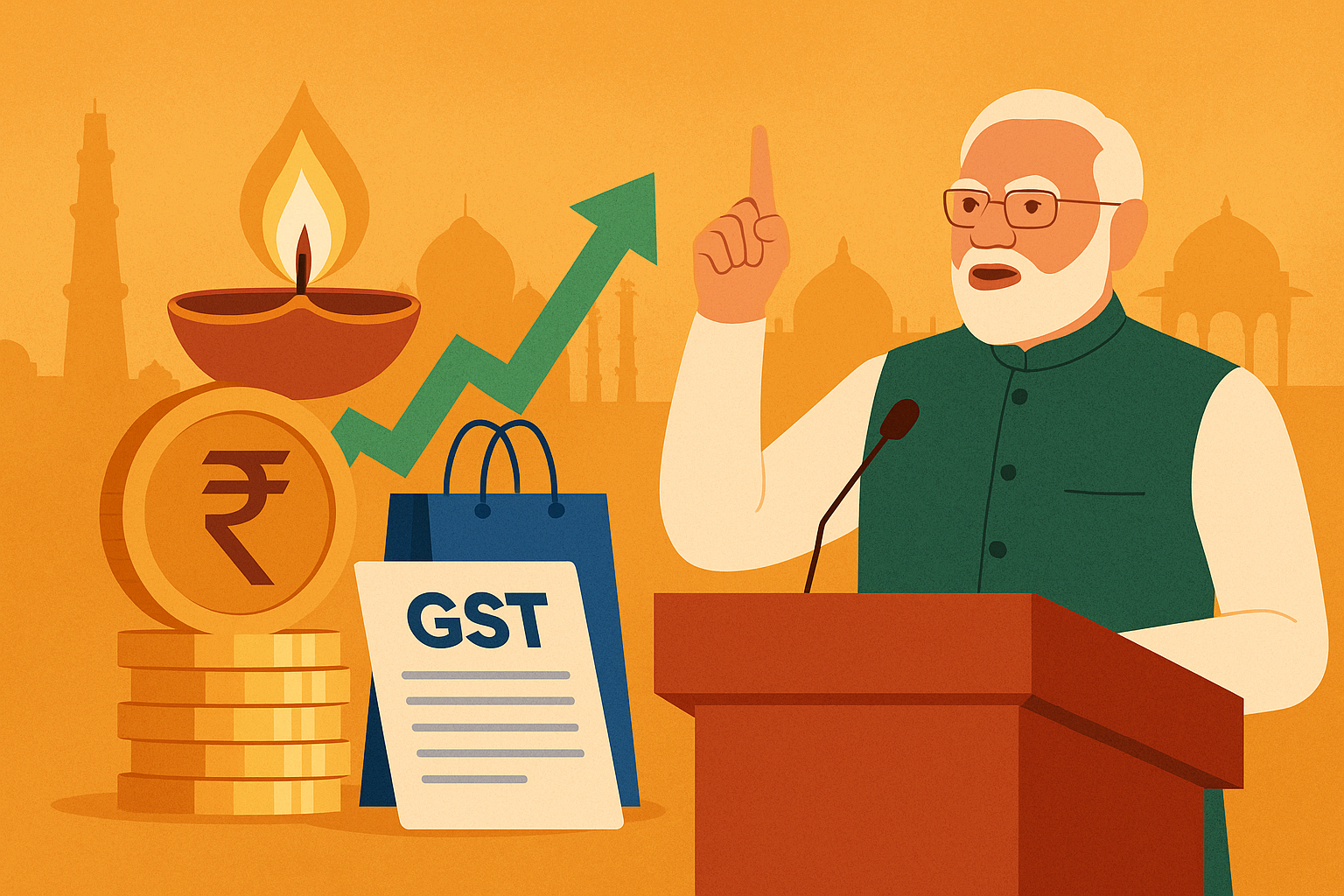India stands at a critical juncture. As global trade faces turbulence—heightened by US President Donald Trump’s steep 50% tariffs on Indian exports—Prime Minister Narendra Modi has unveiled plans for sweeping Goods and Services Tax (GST) reforms. Announced during his Independence Day address, this “Diwali gift” promises to rationalize GST slabs, cut consumer taxes, and revive a domestic economy struggling with weak demand.
A Sharp Cut in GST Slabs
The proposal under discussion seeks to eliminate the current 12% and 28% GST slabs. Reports suggest:
- Most goods in the 12% category would drop to 5% or even 0%.
- Products in the 28% category would largely shift to the 18% slab.
- Luxury and sin goods would remain taxed at 40%, but the phasing out of the Compensation Cess could make them cheaper over time.
This goes beyond tax simplification. It is a bet on consumption-led growth—a hope that cheaper goods at the retail counter will deliver the demand boost that earlier income-tax cuts and monetary easing failed to achieve.
Auto Sector: The Biggest Beneficiary
The auto industry, especially small cars and commercial vehicles, has been struggling with sluggish sales.
- Small Cars: Maruti Suzuki, India’s top carmaker, has been lobbying for GST relief. With small cars set to fall into the 18% slab, prices could drop by 8%, enticing two-wheeler owners to upgrade. Maruti’s stock has already rallied 14% in two weeks.
- Two-Wheelers: Hero MotoCorp and Bajaj Auto may see demand revival if two-wheeler buyers get replaced by new entrants post-GST cut.
- Commercial Vehicles & Tractors: Ashok Leyland, Eicher Motors, and Mahindra & Mahindra stand to benefit as GST on commercial vehicles and tractors could fall to 18% and 5%, respectively.
The Nifty Auto Index has jumped 3.8% since the announcement, outpacing the Nifty 50, which saw a minor 0.5% correction.
FMCG & Consumer Durables: The Demand Story
FMCG demand in India has been tepid, despite interest-rate cuts and fiscal stimulus. Recent price hikes by companies hurt sales volumes, proving that demand here is price-sensitive.
- Price Elasticity: A 4-5% price cut due to GST relief could revive FMCG growth, helping the sector recover from years of underperformance.
- Consumer Durables: Big-ticket items like refrigerators and air conditioners, sold by Voltas and Bluestar, are expected to see faster demand revival than essentials like soap or cooking oil.
If consumption rebounds, it can trigger a chain reaction—improving consumer confidence, lifting private investment, and eventually boosting GDP growth.
Cement Sector: Limited Demand Impact, Premiumization Gains
The GST on cement is expected to drop from 28% to 18%, bringing prices down from ₹350 to ₹325 per bag. However, since cement demand is mostly inelastic—construction costs fall by less than 1%—the cut is unlikely to spark a major volume surge.
Instead, the gains may come from:
- Premiumization: Cheaper prices could accelerate demand for high-grade cement, with penetration expected to rise from 40% to 55–60% by FY30.
- Topline Growth: Companies like Ultratech and Ambuja may benefit as higher-value products capture a greater share of the market.
Banking & Financial Services: A Secondary Beneficiary
If GST cuts succeed in lifting consumption and private capex, banks and financial services firms will gain from higher credit demand. With non-performing asset (NPA) stress expected to bottom out soon, lenders may be poised for a revival.
Risks & Timelines
- Fiscal Costs: The finance ministry estimates a revenue hit of ₹50,000 crore, or under 20 bps of GDP—less than early fears of 30–40 bps.
- Revenue Offsets: If the government raises other taxes to compensate, demand gains could be diluted.
- Timing: The GST Council will finalize details in early September. Demand may even dip in Q2 FY26 as consumers delay purchases until after the Diwali GST cuts, with real benefits visible only from Q3 FY26 onward.
The Bottom Line
GST 2.0 could mark a turning point for India’s economy—if executed well. The auto and FMCG sectors appear best placed for immediate gains, while cement and BFS may benefit indirectly through premiumization and credit growth. But much depends on the fine print, fiscal balancing, and the pace at which consumer sentiment revives in the face of global headwinds.
Feel free to share your experiences and insights in the comments below. Let’s continue the conversation and grow together as a community of traders and analysts.
By sharing this experience and insights, I hope to contribute to the collective knowledge of our professional community, encouraging a culture of strategic thinking and informed decision-making.
As always, thorough research and risk management are crucial. The dynamic nature of financial markets demands vigilance, agility, and a deep understanding of the tools at your disposal. Here’s to profitable trading and navigating the election season with confidence!
Ready to stay ahead of market trends and make informed investment decisions? Follow our page for more insights and updates on the latest in the financial world!
For a free online stock market training by Yogeshwar Vashishtha (M.Tech IIT) this Saturday from 11 am – 1 pm, please sign up with https://pathfinderstrainings.in/training/freetrainings.aspx
Experience profits with my winning algo strategies – get a free one-month trial with ₹15 lakh capital! – https://terminal.algofinders.com/algo-terminal
Disclaimer
This article should not be interpreted as investment advice. For any investment decisions, consult a reputable financial advisor. The author and publisher are not responsible for any losses incurred by investors or traders based on the information provided.


